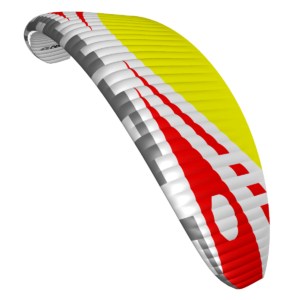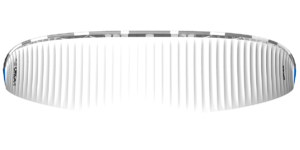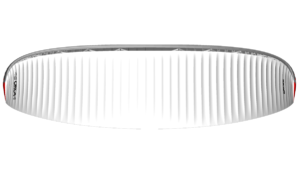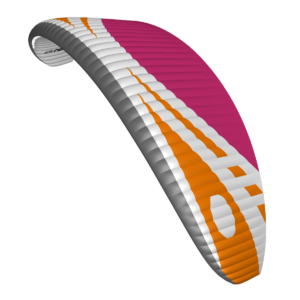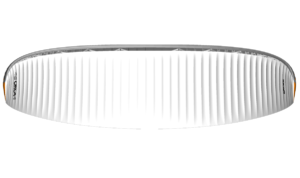Orca 4
Orca 4
Orca 4 is a universal tandem wing of EN B class and 5,4 aspect ratio (53 cells).
It offers exceptionally easy launch, perfect handling and highest passive safety accompanied by performance of a single-seater.

Design and purpose
The paraglider is dedicated both for free-flying with passenger and for light paramotor trikes.
Four-row canopy with rigid cores (Dudek FlexiEdge technology) blends recent experiences of testing other prototypes featuring this technology with long-standing info received over years from happy users of the original Orca. The aspect ratio and other factors were carefully calculated in order to make full advantage of new technologies, while retaining optimal mix of passive safety, performance and steering for this class.
 See movie
See movie
Orca 4 as compared to Orca XX:
- further improved already great launch parameters, precision and ease of steering as well as flaring efficiency during landing,
- slightly increased aspect ratio,
- minor design changes within canopy,
- new, LTF-certified spreader bars.
The aerofoil used in Orca 4 has Shark-nose intakes – they help to internal pressure of the canopy stays stable within wide speed range.
Inner reinforcements, structural cores and mini-ribs perfectly shape and stabilize the aerofoil. Mini-ribs on the trailing edge keep it slim and decrease ballooning, radically improving the airflow. All in all, we succeeded in creating a perfectly balanced design, mixing great performance with safety and stability. In turbulence the paraglider behaves very reassuring and predictable, with efficient damping of both longitudinal and lateral oscillations.
Orca 4 easily inflates and rises, without lagging behind. Then it stabilizes and with slight brake action simply flies away. On the landing approach it is enough to brake down a little in order to markedly decrease speed with ensuing soft touchdown. All tandem pilots appreciate those features, so we’ve put quite an effort into polishing them to perfection.
Design solutions
- Canopy of the Orca 4 body was designed in our CSG (Canopy Shape Guard) system, comprising a number of elements resulting in exceptional coherence and stability of the shape.
- The aerofoil was perfected with DOA technology (Dudek Optimized Airfoil).
- The air intakes are designed and executed in Shark-nose technology.
- Another feature of the Orca 4 is the Flexi-Egde technology.
Careful selection of modern fabrics and design solutions brings about great strength and durability of the Orca 4. All materials used come from marked production batches, and each production step can be verified down to identification of specific worker and controller.
Orca 4 is delivered with tandem spreaders, with LTF certificate:
Orca 4 is manufactured under new technology, utilizing precision of the laser cutter. All stages of production process take place in Poland under strict supervision of the designer himself, thus ensuring highest European quality.
Design solutions, technologies and other functionalities are listed below in the Technologies section.
Construction solutions
Technologies, concepts
Risers functionality
Used solutions
Colours
Parameters
Weight ranges

TECHNICAL DATA
| Name – size | Orca 4 41 |
| Certification | EN/LTF B |
| Approval – ULM identification | Yes |
| Number of cells | 53 |
| Surface area flat [m2] | 41.00 |
| Surface area projected [m2] | 34.83 |
| Span flat [m] | 14.88 |
| Span projected [m] | 11.77 |
| Aspect ratio flat | 5.4 |
| Aspect ratio projected | 3.97 |
| Sink [m/s] | min = 1.1; (+/- 0.1 m/s) |
| Speed* [km/h] | trym = 38; max = 50 (+/- 2 km/h)* |
| Weight of the wing [kg] | 7.27 |
| Total take-off weight – PG** [kg] | 120-220** |
| Total take-off weight – PPG/PPGG*** [kg] | 120-250*** |
| Maximum symmetric control travel at maximum weight in flight [cm] | 65.00 |
| Distance betwen risers [cm] | 55.00 |
| Lines | Technora 1.2 ; 1.3 ; 1.5 ; 1.8 ; 2.3 A-8000 U-050 |
| Cloth | Porcher 38 g/m2 Porcher 32 g/m2 Porcher Hard 38 g/m2 and 32 g/m2 SR-Scrim, SR Laminate 180 g/m2 |
* Speeds are given as estimated for the middle wing size and the middle of its weight range. These speeds can vary within +/- 2 km/h depending on the size, take-off weight and additional factors such as air pressure and temperature.
** The basic rule is to choose the size of the wing so that the take-off weight is in the middle of the weight range. Less weight on the wing (lower range take-off weight) can be considered for foot take-off, when flying in calmer conditions, or when we want to improve economy. More experienced pilots who want to fly dynamically, have higher speed and fly in more demanding wind conditions can consider greater wing loading (take-off weight in the upper range). This is a common option among trike users.
*** Note – the canopy significantly changes its behavior with increasing wing loading. The greater the loads, the greater skill and concentration of the pilot are required.

















